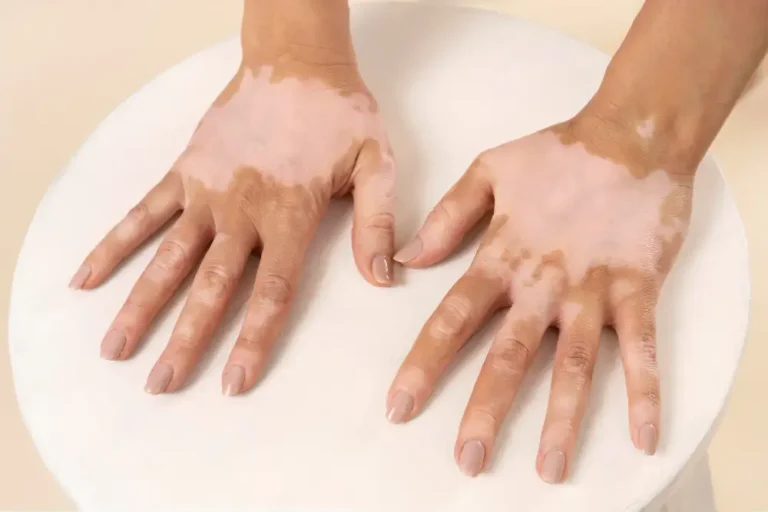Chemical peel treatment or chemexfoliation is an excellent exfoliation strategy for the skin by making use of a skincare product having an acidic pH value of around 2.0. Such a low pH works great for skin exfoliation by removing all the clogged debris and impurities from the skin pores.
The acid solution penetrates into the topmost layer of the skin epidermis and the layer beneath, dermis. This is an ideal treatment option for those having pigmented skin, breakouts or wrinkles.
Classification of chemical peels –
Chemical peels can be classified into three types on the basis of their strength or penetration depth.
- Superficial or light peels – All those individuals who have a dull or rough textured skin or if their skin is lightly pigmented, they require such a peel. All you need is a gentle exfoliator, likely lactic acid, AHA (alpha hydroxy acid) or mandelic acid that have minimum penetration in the skin. Recovery is quicker within hours.
- Medium peels – Medium peels include products with high strength of glycolic acid or Jessner peel that penetrate upto the skin’s middle layer and help in dealing with moderate level skin issues such as scarring, hyperpigmentation or wrinkled skin. Skin needs a few days or a week to fully recover.
- Deep peel – For more intense serious skin conditions such as hyperpigmentation or skin wrinkling or scarring, specialized dermatologists make use of deep peeling technique using a product containing high TCA levels or phenol chemical peels. These penetrate deeper into the skin’s dermis layer. This procedure usually needs anesthesia. The skin’s sensitisation goes away after several weeks.

Mechanism of action of chemical peels –
Chemical peels work on the mechanism of peeling out the outermost layer of the skin using a chemical solution, so that once it peels off, the layer coming up will be younger, fresher and spotless.
Ingredients of chemical peels –
- Enzyme peels – Having the lightest strength of all, these peels are derived from fruits and are purely natural, great for those with sensitive skin. They help to remove the dead skin cells and clean up the clogged pores.
- Lactic acid – This is also a gentle peeling agent that works great for skin hyperpigmentation treating and giving skin a glowing and hydrating effect.
- Mandelic acid – This is little stronger than enzyme peel and helps to deal with fine lines, wrinkles, acne and hyperpigmentation of skin, without causing skin sensitivity.
- Salicylic acid – One of the best treatment solutions for those with acne, salicylic acid peel is oil soluble and deeply clears the clogged pores of debris and sebum.
- Glycolic acid – It belongs to the category of medium peel and is great for dealing with acne scarring. For hyperpigmentation and acne, it works but not as good as salicylic acid.
- TCA peel (trichloroacetic acid) – It’s a medium strength peel working wonders for skin hyperpigmentation and wrinkles.
- Jessner’s peel – This peel is a combination of three ingredients namely salicylic acid, lactic acid and resorcinol, working magnificently on acne and skin pigmentation. But it is more useful on oily skin rather than dry skin.
Beneficial aspects of chemical peels –
- Exfoliation – Skin is made free of all the impurities, even the debris clogged deep inside the pores.
- Treats hyperpigmentation – Those who are facing the issue of hyperpigmentation can be well treated with a chemical peel procedure that works wonders for skin lightening and toning.
- Prevents skin breakouts – Chemical peel is a great exfoliating agent that reduces the content of sebum in the skin, which if found in excess leads to acne.
- Enhancement of skin absorption value – Skincare products become all the more effective post a chemical peel treatment.
- Better skin – This chemical treatment is a great achievement for even skin tone having a smooth texture.
- Anti aging effect – When the outer layer of the skin gets peeled, the skin cells regenerate and give a skin that turns out to be free from fine lines, wrinkles and youthful looking.
- Boosts collagen production – Skin peeling gives a boost to the synthesis of collagen in the skin, a protein crucial for skin’s elastic and youthful appearance.
Side effects of chemical peel treatment –
- Never try doing medium or deep peels at home as they need guidance from skin experts.
- Side effects depend upon the strength of peel used.
- For superficial peels, side effects of redness and skin peeling usually are milder and subside within an hour or two. For deep and medium peels, such changes take at least 7-10 days to subside.
- Try taking good skin care post the treatment yo avoid infection flare up.
Aftercare of chemical peel treatment –
- Any product of acidic nature should not be applied on your face post a chemical peel to prevent skin irritation.
- Hyaluronic acid is a great wound healer. So add a product containing this acid for the after care.
- Using petroleum jelly is also a great option to hydrate the skin post peeling treatment.
- Always apply a sunscreen layer post chemical peel treatment as the skin will be sensitive and should be protected from UV rays damage.
- Do Not pick up the peeled skin as it may lead to scarring.
Bottom line –
This skin resurfacing procedure works as a magic pill to achieve a smoother, blemish free and youthful skin. But always consult a trained dermatologist or cosmetologist regarding this procedure so as to know if you are a suitable candidate.
Looking for a chemical peel treatment for yourself? Wait no further and book an appointment with Dr. Neha Khurana at the House of Aesthetics, Dermatology clinic. Her over 12 years of experience in the field of dermatology will cater to all your problems and guide you to a new era of skin care. Just make a visit and know why she is the best for you. Trust her and discover a new you with blemish free skin!




